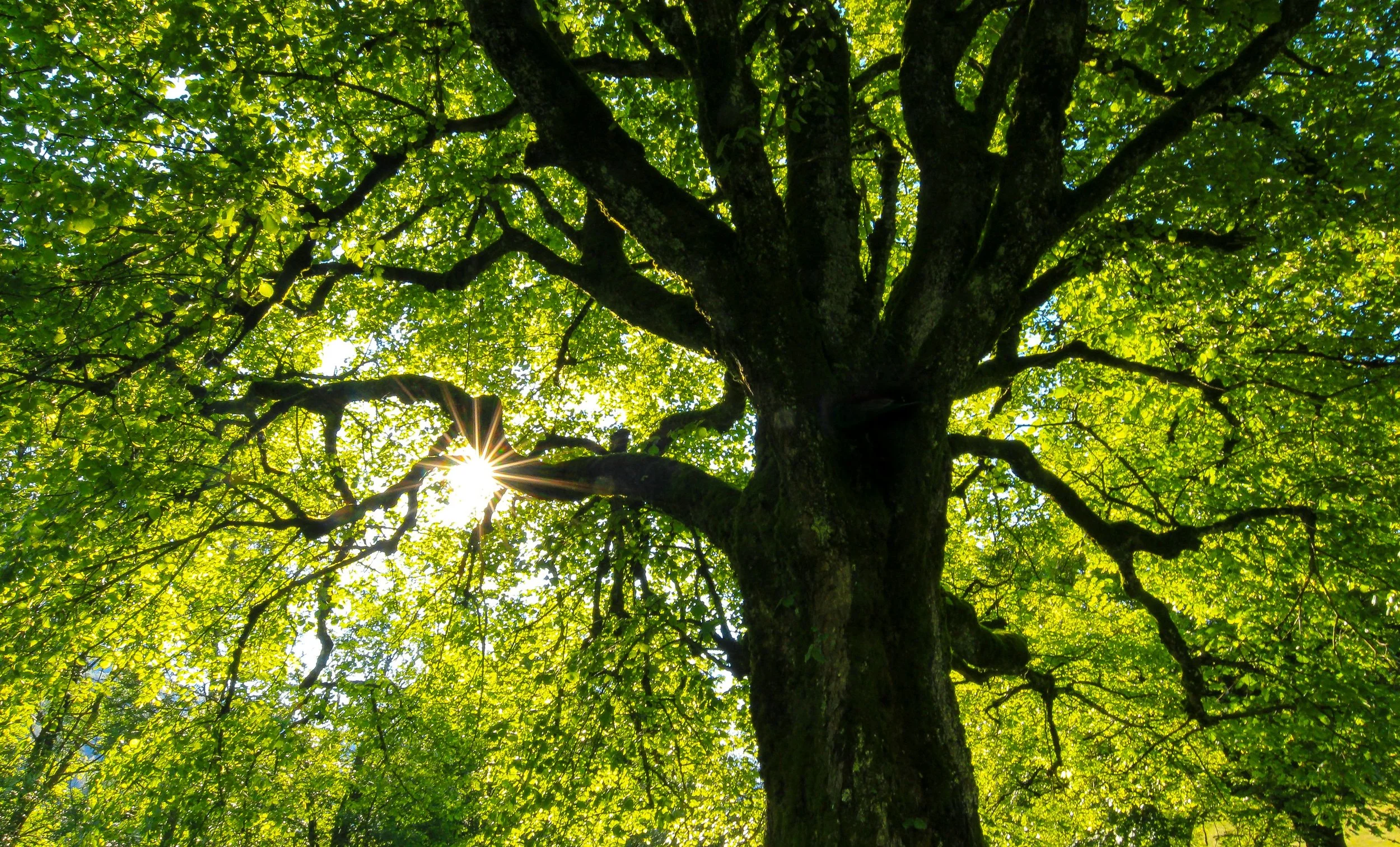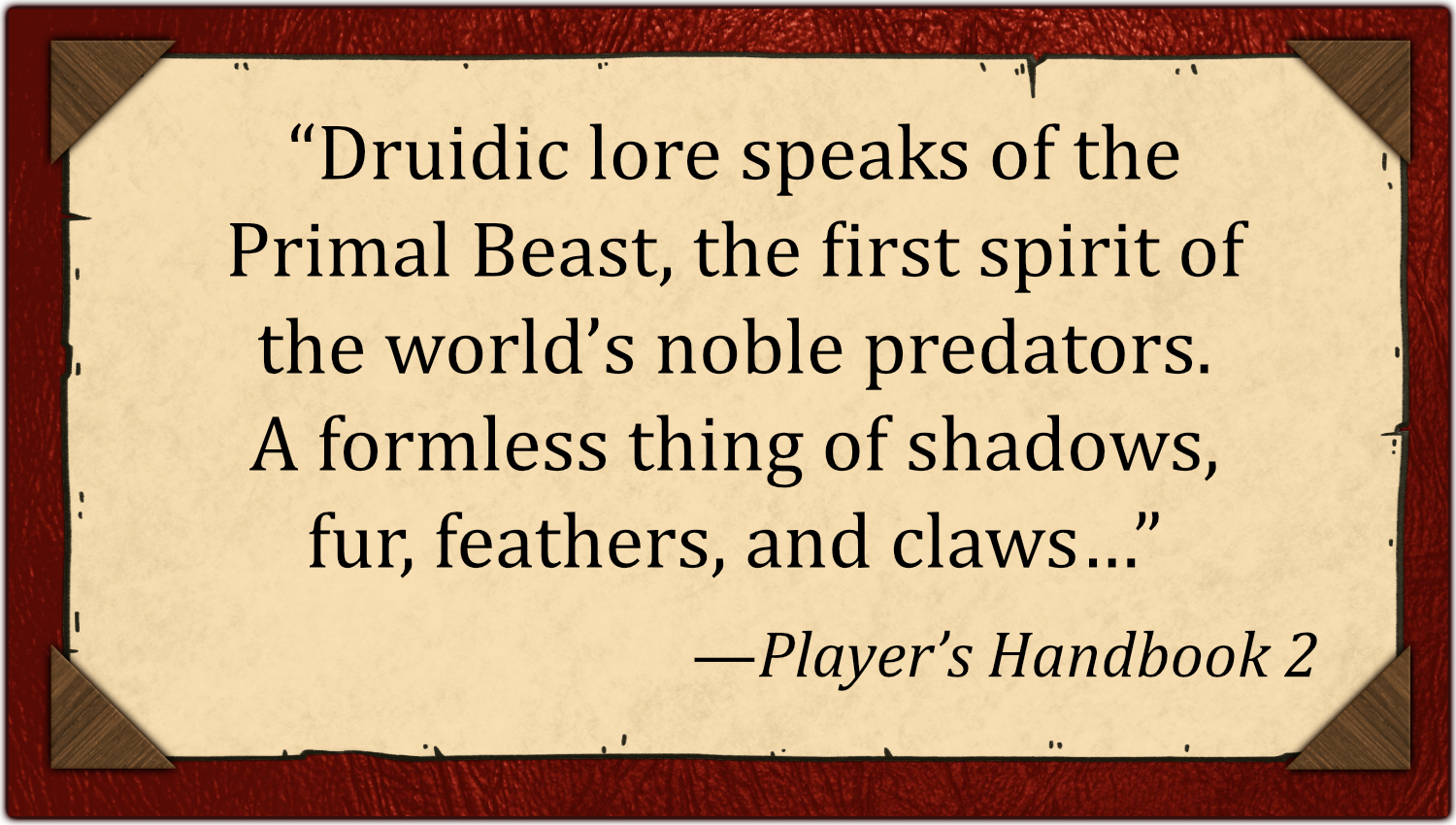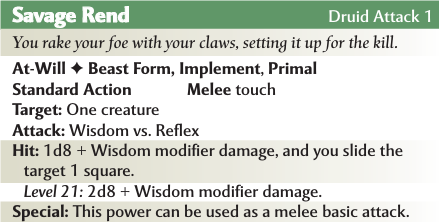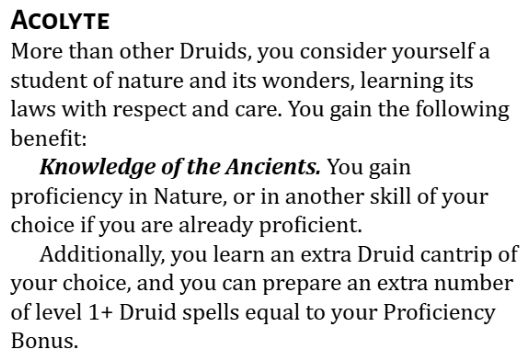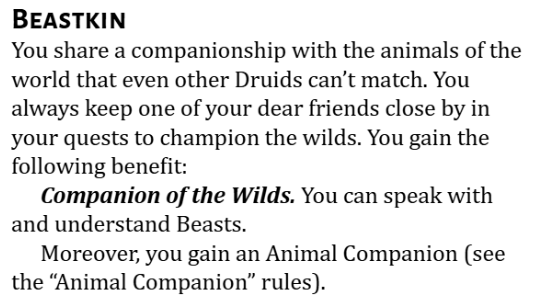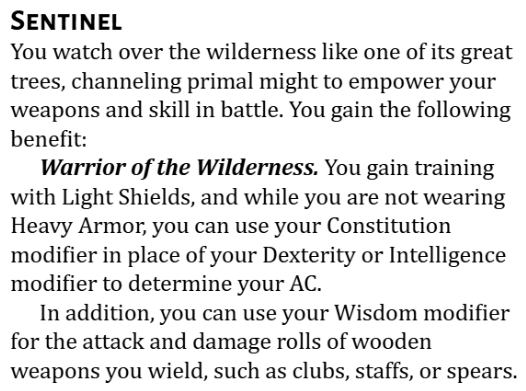Designing 4ever: Stealing from the 4e Druid
Estimated read time: about 10 minutes
Project 4ever is chugging forward at full steam! With public playtesting underway for our first Playtest Packet, we can now spare a glance ahead to what will be coming in “Wave 2”. With the Cleric, Fighter, Rogue, and Wizard already out, what will be the next classes coming down the pipeline? First up for our thoughts today is the Druid!
Throughout the article we’ll be using some terminology from D&D 4e and Project 4ever. If you need a refresher, feel free to check out the previous articles on Power Sources and Combat Roles.
We’re going to start out with a quick review of what the 4e Druid offers. If you’re already familiar with 4e or would like to skip ahead, feel free to jump to the “So What Are We Stealing?” section.
Call of the Wild
The Player’s Handbook 2 of D&D 4e introduced the Primal power source to the game, establishing that “nature magic” isn’t just another flavor of divine magic, but something worthy of its own lore, mechanics, and classes. Druids aren’t mere “nature priests”, but fierce channelers of primal magic who bond with great and ancient spirits of the wilds.
The Druid in that book was the “Primal Controller”, and it usually accomplished its role in two ways: using Wild Shape to make rending melee attacks that hinder foes, or blasting enemies at range with elemental magic. Every Druid had access to Wild Shape at will, and could choose powers that worked in Wild Shape or not as they pleased. We’ll talk more about Wild Shape in a minute.
Other sourcebooks that came out gave additional options for what the Druid could be. The Protector Druid from Heroes of the Feywild generally eschewed Wild Shape for the ability to summon powerful monstrous creatures.The Sentinel Druid from Heroes of the Forgotten Kingdoms was actually a Primal Leader, with an animal companion and empowered weapon attacks rather than Wild Shape or more conventional spells.
About Wild Shape
Players used to 5e’s version of Wild Shape might have a hard time grasping exactly what it entailed in 4e. Rather than choosing and taking on the stat block of an animal, your statistics don’t change. At all. You don’t get another pool of hit points, your size doesn’t change. It’s extremely abstracted in the sense that you just say what animal you want to look like (or even a combination of animals) and that’s what you are in the narrative. Mechanically, being in your beast form just restricts you from using powers that don’t have the “Beast Form” keyword. It does not give you any sort of climb or swim speed, or the ability to breathe water, or fly. At least, not yet.
Sound kind of boring? Well, let’s take a look at some of those powers that do have the Beast Form keyword, because they’re actually really cool.
Savage Rend is an at-will attack power that can only be used in beast form. It lets you “rake a foe with your claws, setting it up for the kill.” Essentially you attack, hit, deal some damage, and you get to slide the target a little bit. In 5e that might not sound like much, but in 4e movement and positioning are everything. You could scooch that enemy away from a vulnerable ally, or to a space adjacent to a Defender, or merely away from you so you can move without provoking an opportunity attack from it. You could send it into hazardous terrain or a damaging zone (maybe something created by you).
Perhaps most importantly, it lets you attack in melee using your Wisdom modifier instead of Strength or Dexterity, making every Druid who invests in this power at least capable of doing some damage and fulfilling its role, unlike a poor Wizard armed with just a dagger.
Here’s another example:
Savage Frenzy lets you attack each enemy adjacent to you! The damage is fairly low, but it’s the attack’s riders that make it worth it: lingering dazed and slowed effects. Many people lament the lack of a “Martial Controller” in 4e, which is fair. But a Druid doing its thing in Wild Shape can be a surprisingly tough Controller that does its role on the front line.
(We have a Martial Controller in the works, by the way, but that’ll have to be for another day.)
One of the most fascinating things about the 4e Druid’s Wild Shape is that it’s fairly optional; you don’t really have to engage with it if you don’t want to. But at the same time, it’s viable for most builds. You get to strike your own balance of relying on Wild Shape or not, and there’s still support and options for your character.
So, What Are We Stealing?
Pretty much everything discussed are all aspects of the Druid that we want to be playable and valid options in Project 4ever. Trying to fit all of the 4e Druid’s flexibility under one umbrella has been quite tricky, but we’ve come up with something that we feel good about sending out for playtesting.
Level 1: Hit Die & Proficiencies
Normally, being a Controller, the Druid would have a smaller Hit Die. A d6 like the Wizard, for example. But since it’s a Primal class it stands to reason that it would be a bit more durable and tough. So we’ve kept the d8 from 5e. For armor, the 4ever Druid has training with all Light Armor: Cloth, Leather, and Hide. It does not get the Medium Armor training from base 5e, or training with Shields.
Level 1: Wild Shape
Now here’s a huge difference from base 5e. We’re stealing 4e’s Wild Shape.
It’s a Bonus Action to transform into your beast form. While in beast form, you get natural weapons of your choice (horns, fangs, claws, etc.) that deal your choice of Bludgeoning, Piercing, or Slashing damage. Using your Wisdom modifier, you can make melee weapon attacks with them against a target’s Reflex Defense, dealing 1d8 damage on a hit plus your Wisdom modifier.
And that’s it, basically, as far as what Wild Shape actually does. You can get other features that tweak your Wild Shape (more in that in a bit), but the feature itself just gives you that melee attack based off of Wisdom. However, there are many new spells that specifically state that you can cast them while in Beast Form.
As with 4e, you don’t have to engage with Wild Shape if you don’t want to. Depending on your spell and feature selection, you can choose to invest in it or not, and you’ll still have plenty of options for spells and actions.
Level 1: Spellcasting
This is mostly back to familiar territory for 5e players. Your spellcasting ability is Wisdom, you pick some cantrips and level 1 spells. Though, you’ll notice a few things: you don’t learn as many spells, and you have only one spell slot and it comes back on a Short Rest.
Remember that article on Spellcasting Progressions? No? Well, if you’ve got more questions about the Druid’s spellcasting progression that would be a good post to go back to. Essentially it’s a “two-thirds” or “three-quarters” spellcaster, built on a chassis we call the “Gish”. It caps out at level 7 spells instead of going all the way to level 9 like the Wizard does. But, like the Cleric (which is also a “Gish”), it has much more going on with it than just spellcasting.
There are a ton of new spells, split fairly evenly between ranged spell attacks and melee weapon attacks. For 4e veterans, you’ll notice that we’ve made an adaptation to these options: attacks you make in Wild Shape are weapon attacks, not spell attacks. So the spells that work for Wild Shape also technically work outside of Wild Shape, you’d just make the attacks with conventional weaponry. More on this in a minute.
Level 1: Balance of Nature
This feature is a deceptively important one, as it has perhaps the most effect on defining your playstyle as a Druid. You get to pick one of four options.
This would be the typical Druid build. You get an extra cantrip and some more prepared spells, just giving you more options to do the things you want to be doing, whether in Wild Shape or not.
This one gives you an Animal Companion! Oh, there are things to say about Animal Companions, more than I can squeeze into this article. But we currently have about 8 to choose from, each with their own effects a Controller can be proud of. Whether you want to charge in alongside your Bear Companion in Wild Shape, or send your Wolf Companion out to run interference for you while you hang back and throw lightning, we’ve got you covered.
This is for the Druid that wants weapons in hand and to be a bit more durable. You get training with Light Shields, you can use Constitution instead of Dexterity or Intelligence for your AC, and you can use Wisdom for the attack and damage rolls of wooden weapons. As far as tough Controllers go, this one might take the cake.
This Wildskin option marks you as the best at the actual transformation part of your Wild Shape feature. It doesn’t require a Bonus Action, and whenever you use it, you get a free 5-ft. shift! Even if you don’t specialize in Wild Shape spells, this is a useful ability to have, letting you maneuver around the battlefield much more easily.
Level 2: Favored Primal Aspect
Okay, for those of you wishing that Wild Shape gave you more advantages for turning into an animal, this feature addresses that. You get a variety of options to pick from that tweak your abilities while in Beast Form. If you want to be able to climb, leap, sneak, or swim with the best, this is where you’ll pick that up.
Level 3: Druid Subclass
The base 5e Druid subclasses generally fall into two groups: Circle of the Moon, and everything else. Seriously. If you want to be effective in Wild Shape, you pick Circle of the Moon. If you don’t want your combat effectiveness to rely on turning into an animal, you go with any of the other subclasses, some of which are better than others.
We wanted to avoid this sort of split in Project 4ever, so we’ve tried to make every subclass viable whether or not you invest in Wild Shape.
Our top three subclasses for the Druid currently are:
Circle of the Land: Draw elemental power from the mighty continent under your feet.
Circle of the Moon: Employ healing and trickery through the phases of the moon.
Circle of Spores: Channel the powers of fungus, infection, and nature’s necromancy.
Level 4: Primal Inspiration
This is the first Primal class to come through our design cycle, so its additional rider to using Inspiration is different from any other class shown so far.
Here’s what it looks like:
It’s not straight-up healing like the Divine classes, but because there are a few things that key off of spending Healing Surges, regaining one can be a pretty big deal on its own. Personally, I’m not sure this feature is quite up to snuff yet compared to the classes of other power sources, so it (like everything in these articles) is subject to change. But let us know in the comments what you think!
Level 5: Combat Prowess
Okay, now this is exactly like the Cleric’s level 5 feature of the same name (since they’re built on the same advancement chassis, right?) so those readers who remember will know what it does. But here it is:
So you get a straight-up damage boost to your choice of weapon attacks (including those made in Wild Shape), or with spell attacks that include your implement damage. But if this is a difficult choice for you, remember that you can have the best of both worlds a little later on as you continue to level up. This is just deciding which combat style you want to improve first.
Wrapping it Up
At long last, that’s it! The 4ever Druid, or at least the first five levels of it. As it joins the ranks of the Cleric, Fighter, Rogue, and Wizard for public playtesting, our next blog article will look ahead to another new 4ever class: the Monk.
Remember that if you’ve got any feedback or want to join us in playtesting Project 4ever, we’ve got a Discord server set up where you can get to know us and other awesome members of our growing community. Come by and say hi, hit us with some questions, and join a playtest session!
Until then, happy gaming, and we’ll see you in the Archives!


